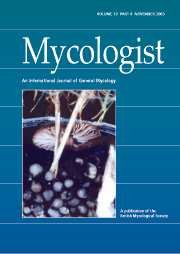Crossref Citations
This article has been cited by the following publications. This list is generated based on data provided by
Crossref.
2000.
21st Century Guidebook to Fungi.
p.
85.
Gerlee, P.
and
Anderson, A. R. A.
2007.
Stability analysis of a hybrid cellular automaton model of cell colony growth.
Physical Review E,
Vol. 75,
Issue. 5,
Davidson, Fordyce A.
2007.
Fungi in the Environment.
p.
58.
Davidson, Fordyce A.
2007.
Mathematical modelling of mycelia: a question of scale.
Fungal Biology Reviews,
Vol. 21,
Issue. 1,
p.
30.
Cunniffe, Nik J.
and
Gilligan, Christopher A.
2008.
Scaling from mycelial growth to infection dynamics: a reaction diffusion approach.
Fungal Ecology,
Vol. 1,
Issue. 4,
p.
133.
Rajal, Verónica Beatriz
and
Cuevas, Carlos Mario
2008.
Culture of Penicillium ulaiense in a batch-reactor: stoichiometric studies.
World Journal of Microbiology and Biotechnology,
Vol. 24,
Issue. 7,
p.
1081.
Rosling, Anna
Roose, Tiina
Herrmann, Anke M.
Davidson, Fordyce A.
Finlay, Roger D.
and
Gadd, Geoffrey M.
2009.
Approaches to modelling mineral weathering by fungi.
Fungal Biology Reviews,
Vol. 23,
Issue. 4,
p.
138.
Heaton, Luke L. M.
López, Eduardo
Maini, Philip K.
Fricker, Mark D.
and
Jones, Nick S.
2010.
Growth-induced mass flows in fungal networks.
Proceedings of the Royal Society B: Biological Sciences,
Vol. 277,
Issue. 1698,
p.
3265.
Montoya Barreto, Sandra
Orrego Alzate, Carlos E.
and
Levin, Laura
2011.
Modeling Grifola frondosa fungal growth during solid‐state fermentation.
Engineering in Life Sciences,
Vol. 11,
Issue. 3,
p.
316.
Heaton, Luke L. M.
López, Eduardo
Maini, Philip K.
Fricker, Mark D.
and
Jones, Nick S.
2012.
Advection, diffusion, and delivery over a network.
Physical Review E,
Vol. 86,
Issue. 2,
Juan, Yang
Yin, Zhao Jing
Hailong, Yu
LiHua, Tang
and
RuiJuan, Wang
2012.
Mathematical study of the effects of temperature and humidity on the mycelium growth of Pleurotus eryngii.
p.
1.
Hopkins, Steven
and
Boswell, Graeme P.
2012.
Mycelial response to spatiotemporal nutrient heterogeneity: A velocity-jump mathematical model.
Fungal Ecology,
Vol. 5,
Issue. 2,
p.
124.
Yang, Juan
Zhao, Jingyin
Yu, Hailong
Wang, Yunsheng
Wang, Ruijuan
and
Tang, Lihua
2013.
Computer and Computing Technologies in Agriculture VI.
Vol. 392,
Issue. ,
p.
312.
Ferreira, Iuri Emmanuel de Paula
Moral, Rafael de Andrade
Ferreira, Cláudia Pio
and
Godoy, Wesley Augusto Conde
2013.
Modelling fungus dispersal scenarios using cellular automata.
Ecological Informatics,
Vol. 14,
Issue. ,
p.
53.
Jung, Dae Ho
Kim, Chan Kyo
Oh, Kyung Hun
Lee, Dong-Hyeon
Kim, Minsu
Shin, Jong Hwa
and
Son, Jung Eek
2014.
Analyses of CO2 Concentration and Balance in a Closed Production System for King Oyster Mushroom and Lettuce.
Horticultural Science and Technology,
Vol. 32,
Issue. 5,
p.
628.
Lin, Xiao
Terejanu, Gabriel
Shrestha, Sajan
Banerjee, Sourav
and
Chanda, Anindya
2016.
Bayesian model selection framework for identifying growth patterns in filamentous fungi.
Journal of Theoretical Biology,
Vol. 398,
Issue. ,
p.
85.
Fricker, Mark D.
Heaton, Luke L. M.
Jones, Nick S.
Boddy, Lynne
Heitman, Joseph
and
Gow, Neil A. R.
2017.
The Mycelium as a Network.
Microbiology Spectrum,
Vol. 5,
Issue. 3,
Fricker, Mark D.
Heaton, Luke L. M.
Jones, Nick S.
and
Boddy, Lynne
2017.
The Fungal Kingdom.
p.
335.
Tudryn, Gregory J.
Smith, Leah C.
Freitag, Jamie
Bucinell, Ron
and
Schadler, Linda S.
2018.
Processing and Morphology Impacts on Mechanical Properties of Fungal Based Biopolymer Composites.
Journal of Polymers and the Environment,
Vol. 26,
Issue. 4,
p.
1473.
Ghanbari, F.
Costanzo, F.
Hughes, D.P.
and
Peco, C.
2020.
Phase-field modeling of constrained interactive fungal networks.
Journal of the Mechanics and Physics of Solids,
Vol. 145,
Issue. ,
p.
104160.




